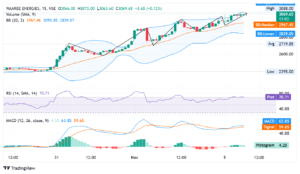Waaree Energies Ltd., an eminent name in India’s renewable energy sector, primarily engages in manufacturing solar photovoltaic (PV) modules, executing solar projects, and generating electricity. Founded in 1989, the company has steadily evolved to become one of India’s largest solar panel manufacturers, with a strong focus on innovation, quality, and sustainability. Its comprehensive solar offerings include PV modules, inverters, mounting structures, and related solar power solutions, making it a one-stop provider for solar power needs.
The company’s substantial impact in renewable energy has earned it a strong position within the sector, reinforcing India’s efforts toward a greener future. Waaree’s impressive growth trajectory reflects its commitment to quality and resilience amidst a competitive market landscape.
A Market Overview: Solar Power in India
Solar energy, an indispensable part of India’s renewable energy portfolio, is crucial to achieving the nation’s ambitious climate goals. India’s solar industry has seen significant growth over the past decade, driven by supportive government policies, a decrease in PV module prices, and increased public awareness of the importance of renewable energy.
As of recent years, India is among the leading countries in solar energy generation, and companies like Waaree Energies have contributed immensely to this achievement. The government aims to reach a target of 280 GW of solar capacity by 2030, an objective in which Waaree Energies, with its robust manufacturing capacity, has been a vital contributor.
Waaree Energies’ Core Business Segments
Waaree Energies operates across three primary business segments:
- Manufacture of Solar PV Modules: Waaree is one of India’s largest solar PV module manufacturers, with an installed production capacity of over 9 GW. The company specializes in advanced technology for module production, offering modules with high efficiency and durability, suitable for diverse weather conditions. Waaree’s manufacturing facilities are known for strict quality control and compliance with international standards.
- Solar Project Development: In addition to manufacturing, Waaree provides end-to-end solutions for solar power projects. The company has been involved in several large-scale solar power plant projects, handling all stages from planning and procurement to execution. Waaree’s experience in project management, combined with its strong technical expertise, enables it to execute high-quality solar installations on time and within budget.
- Sale of Electricity: Waaree also generates electricity and sells it to various sectors, including residential, commercial, and industrial. This business model aligns with the company’s strategic focus on sustainable revenue streams and diversifies its offerings beyond manufacturing, thus enhancing its stability and growth potential.
Recent Performance and Milestones
Crossing All-Time Highs
On its most recent trading day, Waaree Energies’ stock closed at ₹2,990.60, marking a significant milestone. This price reflects a 2.77% increase from its previous all-time high of ₹2,910. This surge indicates strong investor confidence in the company’s performance and potential, further underscoring Waaree’s pivotal role in India’s renewable energy sector.
Crossing 52-Week Highs
The same stock price also broke through Waaree’s previous 52-week high, standing at ₹2,910, again by 2.77%. Such a consistent upward trend in stock prices is a testament to Waaree’s market stability and investor trust. The stock’s performance also highlights the company’s ability to deliver value consistently despite market fluctuations.
Technical Analysis: Chart Indicators and Support Levels

A recent technical analysis of Waaree Energies’ stock shows promising signs of continued momentum:
- Support at 20 SMA: The stock has been consistently taking support at the 20-period simple moving average (SMA) on the chart. This level acts as a strong support line, suggesting that buyers are stepping in at this point, which adds stability to the stock and minimizes downward volatility. When a stock takes support at its 20 SMA, it indicates a sustained bullish sentiment among investors.
- Bollinger Bands: The stock price has been trading near the upper Bollinger Band, signifying bullish momentum. Moving close to the upper band typically suggests that the stock may be overbought. However, in a strong uptrend, this pattern can persist as long as buying interest remains high.
- Relative Strength Index (RSI): The RSI indicator currently reads 70.71, close to the overbought threshold. This elevated RSI level indicates that the stock might experience a short-term correction, as it approaches the upper limits of buying activity. However, in strong uptrends, stocks can maintain high RSI levels for extended periods.
- MACD (Moving Average Convergence Divergence): The MACD line is above the signal line (63.85 vs. 59.65), indicating bullish momentum. This crossover, along with a positive histogram at 4.20, further suggests that the stock may continue its upward trajectory in the near term.
Financial Performance and Shareholding Structure
Promoter Holdings and Institutional Investments
Waaree Energies’ shareholding structure is a balanced mix of promoters, financial institutions, and public shareholders:
- Promoters: The promoters hold a significant 64.3% of the total shareholding, indicating strong ownership and a commitment to long-term growth. High promoter holding often reflects the management’s confidence in the company’s future, as they have a vested interest in driving its success.
- Foreign Institutional Investors (FIIs): FIIs hold 2.23% of the total shares, which may seem modest but indicates the company’s gradual appeal to global investors.
- Domestic Institutional Investors (DIIs): DIIs hold around 2.09% of the shares. This includes investments by mutual funds, insurance companies, and other domestic institutions, showcasing confidence from India’s domestic financial sector in Waaree’s potential.
- Public Shareholding: Public shareholders constitute around 31.38%, allowing retail investors to participate in Waaree’s growth journey. The high percentage of public shareholding reflects the company’s popularity among retail investors and its commitment to being a publicly accountable enterprise.
Strategic Growth Drivers
Several strategic initiatives underpin Waaree’s growth and bolster its position within the solar energy market:
- Expansion in Manufacturing Capacity: Waaree has been consistently expanding its manufacturing capabilities. With an eye on scaling up production, the company aims to meet the growing demand for solar PV modules both domestically and internationally.
- Technological Innovation: Waaree focuses on innovation, integrating advanced technologies into its products to enhance efficiency and longevity. The company’s R&D efforts are aimed at reducing the cost of solar power while increasing energy output.
- Focus on Quality and Reliability: Waaree’s commitment to quality and strict compliance with global standards has strengthened its reputation. By offering reliable, high-performance products, Waaree ensures customer satisfaction and brand loyalty.
- Strong Brand Presence and Market Expansion: Waaree Energies has been expanding its market presence, targeting regions beyond India. It has established distribution networks in over 68 countries, with a particular focus on high-growth regions like Africa, the Middle East, and Southeast Asia.
- Government Support for Renewable Energy: Waaree benefits from the favorable policy environment in India, including government subsidies, tax incentives, and the recent Production-Linked Incentive (PLI) scheme for domestic manufacturing of solar products. These policies have helped Waaree to grow its production base and compete more effectively with global players.
Challenges and Risks
Despite its achievements, Waaree Energies faces several challenges and risks that could impact its future performance:
- Intense Competition: The solar industry in India is highly competitive, with numerous domestic and international players vying for market share. To maintain its position, Waaree needs to consistently innovate and offer competitive pricing.
- Dependence on Government Policies: Waaree’s business model relies heavily on favorable government policies, subsidies, and incentives. Any changes in these policies could impact the company’s cost structure and profitability.
- Raw Material Costs and Supply Chain Issues: Solar PV manufacturing requires specific raw materials, and fluctuations in raw material prices or supply chain disruptions could impact Waaree’s production costs.
- Currency Fluctuations: With its global presence, Waaree is exposed to foreign exchange risk. Currency fluctuations could affect its earnings from overseas markets, impacting overall profitability.
- Technological Advancements: The renewable energy industry is fast-paced, with new technologies constantly emerging. Waaree must continue investing in R&D to stay ahead of competitors and offer cutting-edge solutions.
Waaree Energies’ Contribution to a Sustainable Future
Waaree Energies is deeply committed to sustainability and environmental responsibility. By manufacturing high-quality solar PV modules and expanding the use of solar energy, Waaree plays a significant role in reducing India’s carbon footprint. The company’s initiatives align with India’s national mission of reducing greenhouse gas emissions and promoting renewable energy sources.
Furthermore, Waaree’s community-driven projects have brought clean energy to rural and underserved regions, contributing to social development and energy access. Its efforts to support a sustainable energy ecosystem not only benefit the environment but also enhance the company’s reputation and credibility.
Future Outlook
Waaree Energies appears well-positioned for future growth, given the rising global demand for renewable energy and the Indian government’s commitment to clean energy goals. The company’s strategy to expand production, explore new markets, and invest in innovation indicates its readiness to meet both domestic and international solar demands. Additionally, as more companies and households transition to renewable energy, Waaree’s offerings are likely to see increased adoption.
ALSO READ: TVS Motor Company: Stock Analysis and Market Performance




